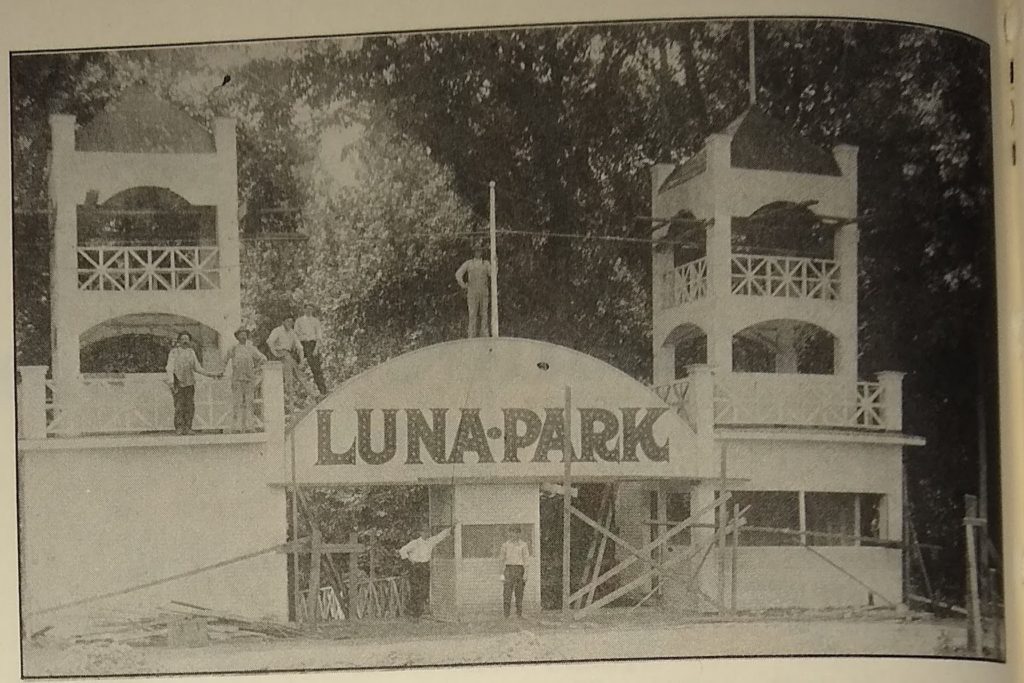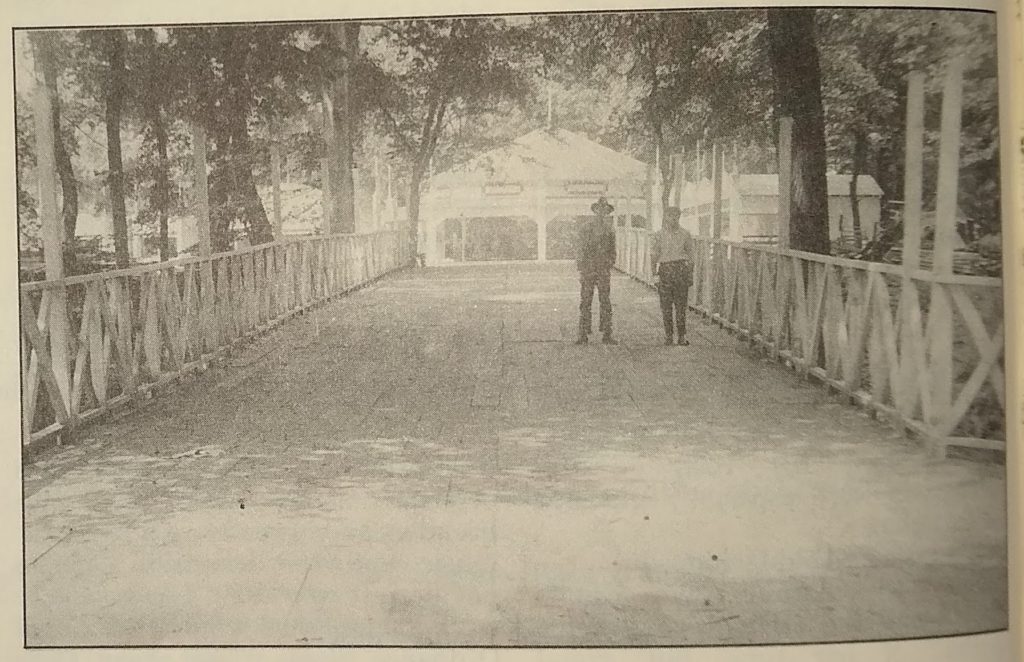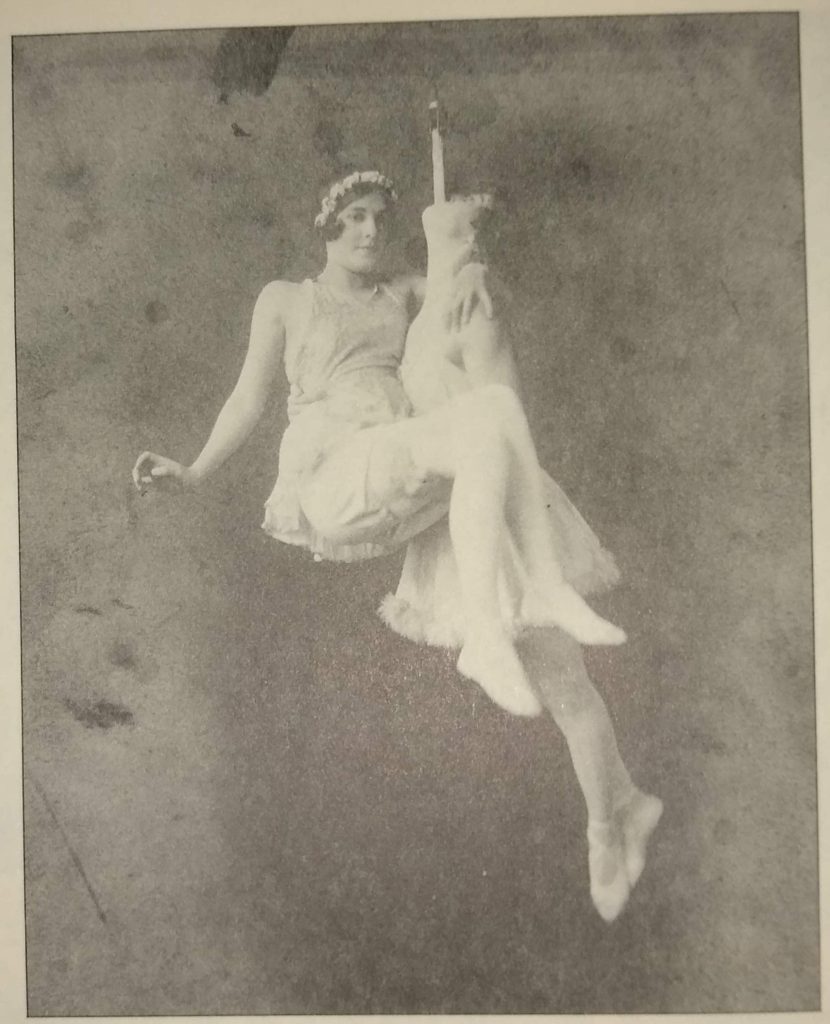Remembering Luna Park
by Louise Bing | GOLDENSEAL Fall 1982

What makes a place famous? If it gives entertainment and joy to men, women and children, it is pretty apt to become famous. And that’s what Charleston’s old Luna Park did. It supplied amusement, entertainment, and joy to the people of Charleston and the surrounding countryside. It had something for all ages, from tiny tots on up. Teenagers were especially glorified at this place.
Luna was a old-fashioned amusement park, nothing like King’s Island and the other great “theme parks” of our time, but grand enough for its day. Its location was on Charleston’s West Side, on the bank of the Kanawha River at Park Avenue. The park covered several acres of ground, and was owned by J. B. Crowley. Mr. Crowley was known among Charlestonians as a partner in the local firm of Ashley & Crowley, tobacco wholesalers specializing in fine cigars. His businesses kept him fully occupied, and Richard Gresham, my neighbor and former Luna Park employee, remembers that Mrs. Crowley was actually “in charge of everything that went on in the park.”
Luna Park’s main building was a huge wooden structure with a wooden fence, near the present site of the West Side Women’s Club on Kanawha Boulevard. Trolley cars brought whole families right to the entrance, while steamboats dropped boatloads of people at the nearby waterfront. Such excursion boats came from as far away as Point Pleasant and Gallipolis, leaving their passengers early in the morning for a full day of fun.
When my sister and I moved to Charleston from Ohio we soon heard of Luna Park. We went there with friends, and greatly enjoyed the music and the beautiful dancing pavilion. It was 1918. I had come to work at the South Charleston Naval Ordnance Plant, where armor plate was made for our battleships then fighting the First World War.
Over 60 years have passed since my first visit to the park, and I recently decided to try to locate others who had gone there as I had, to enjoy what it had to offer. I inquired through the popular “Hot Line” column of the Charleston Daily Mail. Within a few days several people had called or written, and the newspaper forwarded more than a dozen letters to me, some containing pictures. Others called directly, and in all I heard from about 18 people.
Most who contacted me are now in their 70’s or 80’s, and all were enthusiastic about a GOLDENSEAL story on Luna Park. Talking to me they recalled many things about the park, and as they stirred up their recollections other things came to mind that they had not thought of for years. “It all comes back to me as we talk about it,” Mrs. Gordon Carter told me.
One of the first to contact me was local historian Harry Brawley, who sent a letter and pictures. Although very small at the time, he remembers being taken to the park for family picnics, often on the Fourth of July.
Brawley says he was fascinated by the concession stands, spinning “wheels of fortune,” and rows of dolls waiting to be knocked over by baseballs. “There were shooting galleries, with moving ducks serving as targets,” he recalls. “I remember winning a basket of groceries at one of the spinning wheel concessions. The roller coaster was impressive, but my parents would not let me ride it—the merry-go-round was my speed.” Brawley adds that the family almost always rode the trolley car to the Park.
Lance Withrow also remembers Luna Park. Now living in Ronceverte, he spent his early years in Charleston and worked for a time with his brother at the Whittemore Glass Company in nearby Dunbar. While in Charleston he lived at 104 Elm Street, near the park. As a teenager he was greatly taken with the roller coaster, the skating rink, and the boxing ring, where he saw some good professional fighters. One, he says, was Eddie Forbes, then nationally ranked second in the fly-weight class.
“I spent many happy hours at Luna Park in those long gone-by days,” he says. “I remember a fortune teller who told me I’d live to be 76,” Mr. Withrow, now 78, recalls. But, he adds, “another one predicted I’d make it to 95.”

Richard Stanley, now living on Quarrier Street in Charleston, wrote of his own memories of Luna Park. He recalls Sunday afternoons when his parents took him and a younger brother to the park, where their mother spread food on picnic tables for dinner. Rope swings hung from trees, where he and his brother played. He remembers that the price of admission was only a dime, with other charges for activities within the park. Those who came only for a picnic and to enjoy the outdoors paid for no more than the entrance ticket.
Mr. Stanley has particularly fond recollections of “the roller coaster, the merry-go-round, the shooting gallery, bandstand, and the free outdoor movies. There was also a ferris wheel. There were games of chance, such as a roulette wheel, and a bowling place where, if the ball you rolled fell into a certain pocket, you won a prize.” Perhaps influenced by happy childhood memories of Luna Park, Stanley later became manager of Edgewood Park, another old Charleston amusement park at the head of Edgewood Drive.
I also talked to Mrs. Gordon Carter, who grew up in a house alongside Luna Park. She was a tiny child when her parents moved there from Bridge Road, in Charleston’s South Hills. Today, she speaks of the “slicky slides,” swings, and other things that caught a little girl’s eye. She particularly remembers some of the Luna Park regulars, including the champion roller skating twins, Okey and Gus Harmon, and skater “Bum” Gresham. She recalls high wire acts, and prizes won at the shooting gallery.
R. W. Miller, then living on Charleston’s Main Street, also had the good fortune to grow up near Luna Park. As a neighborhood child, he remembers frequent visits to the Luna playground. He also recalls people who worked at the park. “There was a high board fence around the Luna Park building, and the caretaker was John Daily,” he says. “He had a big white bulldog that helped him watch over the place. The root beer stand was operated by Walter Dean.
“There was a greased pole that the kids tried to climb, to win the $5 bill that was on top,” Miller adds, without saying whether he himself ever tried it. “Few kids ever got to the top of that pole. They also had a greasy pig race.”
James E. Thomas, now 68, contacted me from his home in Putnam County. He was about eight when be went to work at the park, picking up trash and paper. Colorful balloons were sent up from Luna Park each morning, he says. His father, Lee Thomas, was in charge of rounding up the balloons when they landed, and James recalls that they came down all over the place, sometimes in the river. He also remembers an unusual game of skill. Baseballs were thrown against a target, which sent six little pigs—real, live pigs—down a chute.

J. F. Johnson also remembers the Luna Park balloons. He’s now 76 and living in St. Albans, but as a child he lived right across the river from the park. Of the balloons, he remembers that a large one came down in his father’s garden, destroying the plants there. Park management paid for the damage, he says. Johnson also recalls taking a ferry boat across from South Charleston to the Luna Park landing. He remembers grand firework displays that lighted Charleston’s night sky on the Fourth of July and other holidays.
Miller and Thomas recall greased pigs and prize pigs, but there were more exotic animals as well. R. W. Wear of St. Albans, now 76, remembers Luna Park’s zoo. “I was about 10 years old when I went there,” he says. “I liked the animals in the little zoo, and I remember very well a monkey that bit my hand when I put it through the wire cage.”
Most of the people I talked to remembered Luna Park from the perspective of their childhood, but Mrs. Paul Larson recalled taking her own child there. Mrs. Larson, now 79, was married at age 16 and was soon taking her little boy to the park. She remembers that Charleston showman Captain David Latlip [GOLDENSEAL, April-June 1979] furnished the merry-go-round at Luna Park, and that the hand-painted horses had “real hair tails.” While her son enjoyed Cap Latlip’s carousel, perhaps with young Harry Brawley, Mrs. Larson recalls roller skate dancing with the Harmons and other accomplished skaters of the period. She also told me that John Phillip Sousa brought his famous march band to Luna Park for at least one afternoon concert long ago.
Like others, Pearl Harler of Charleston remembered working in the park, in her case selling tickets at the main gate. Mrs. Harler, 82 at the time I interviewed her, has since died.
Sometimes whole families were associated with the park in a professional way. My 82-year-old neighbor, Richard Gresham—skater Bum Gresham’s brother—was in charge of Luna Park’s famous roller coaster when he was about 20. Mr. Gresham’s sister Lucille sold admission tickets, and a sister-in-law, Alicia Cornwell, sometimes performed there. Miss Cornwell, a trapeze artist whose stage name was “Aerietta,” traveled with Ringling Brothers and other circuses, and was brought home to Luna Park by the promoter “Marvelous Melville.” In 1935 she met an untimely death from a fall, while performing with a Shrine Circus in St. Louis.

Luna Park gave enjoyment for less than a decade, for it was lost to a great fire on May 5, 1923, the same day that Charleston’s Yellow Pine Lumber Company burned to the ground. Newspaper accounts reported the very extensive damage to the park, with the swimming pool building, dance pavilion, skating rink, and almost all the eastern part of the midway destroyed, and the roller coaster partly burned. Nonetheless, the management bravely announced that the damage would be repaired, and Luna Park would open as scheduled on May 19.
Unfortunately, that never happened. Luna Park was not rebuilt and today lives only in the vivid recollections of older West Virginians, those of us who thrilled to its fun and excitement nearly a lifetime ago. Herman Monk of Beckley spoke for many when he recalled his first trip to Luna, with his father and two cousins, at age 13.
“To a country boy that park was heaven,” he told me. “The lights, the music, the crowds—it was something to behold.”
